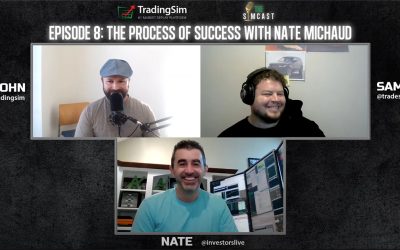Today was another great day in chat. The market has been exceptionally hot lately and we’re killing it! A lot of people reach out to me and ask how we do it.
The answer is simple: we follow rules.
Yes, trading takes a lot of hard work and in no way is it something you can master over night. Trading requires a lot of dedication, studying, and practice. That being said, if you follow a set of trading rules, you can limit your losses and maximize your profit potential. Trading rules give you the structure you need to approach the market with confidence.
Do you ever get stuck in a position and not know what to do?
Do you find yourself rationalizing a trade after you’re already in?
There should be no “hoping” and guesswork in trading. Trading is about creating a plan and having the discipline to follow through with it.
Here are a few of my main trading rules
Everyone will have different trading rules, and what works for some may not work for others. These are the rules I follow that allow me to consistently profit from trading.
When I follow them, I make money. When I ignore them, I pay the price.
Trade the Ticker, Not the Company
This is the foundation for all of the trading we do at Investors Underground. We focus on a stock’s price action – that’s it. We don’t care about the company’s P/E ratio, book value, management team, or future potential. Sure, that information can be useful, but we care about how the stock is trading during the day. This approach is incredibly helpful because it simplifies our trading style. We don’t have to dig through SEC files or research a company for hours. We just look at how it is trading. Price action doesn’t lie.
This approach also helps you avoid rationalization after you enter a trade. If you find yourself on message boards or Yahoo Finance looking for ways to justify your position, you’re probably trying to rationalize a bad trade. Don’t focus on the company, focus on the stock.
If You Don’t Have a Plan, You Don’t Have a Trade
Trading is pretty simple if you break it down to the basics.
- You formulate a hypothesis (what you think the stock will do)
- You enter a trade
- You’re proven right or wrong (you make money or lose money)
- You exit the trade
You clearly have full control over steps 1,2, and 4. You do not have control over how a stock moves so you cannot control step 3 BUT you can plan for it.
What are you going to do if the stock moves in your favor?
What are you going to do if it moves against you?
This is why you need a plan.
A trading plan allows you to control step 3. If you have a plan, there are no surprises. You’re either right or wrong and you react accordingly.
Nail and Bail, Don’t Stay and Pray
This trading rule speaks to the concept of greed and speculation. For example, you enter a position in a stock at $3 and it runs to $4. Your plan (as discussed above) tells you to sell at $4, but then you begin thinking, “Well, what if it goes to $5?”
These “What if’s?” have no place in trading. You make a plan, follow through with it, and don’t look back. We are day traders. I’d rather leave profits on the table than expose myself to unnecessary risk.
Less is More
A photo posted by Nathan Michaud (@investorslive) on
I constantly need to remind myself of this rule. Sometimes trading less is more. If you look at many successful day traders, most of their gains come from a few great trades. If you’re placing thousands of trades, they’re not all going to be home runs. It’s similar to the 80/20 rule, where 80% of the effects come from 20% of the efforts. In trading 80% of the gains come from 20% of the trades.
This means that you shouldn’t trade just for the sake of trading. You should focus on putting more of your effort into the best setups and ignoring the lower probability ones. This doesn’t mean you should trade less just for the sake of trading less. It means that you should analyze where you are making the most of your money and focus your efforts there.
What Are Your Trading Rules?
Now you know four of the rules I use to guide myself during trading. The list is much longer, but these are the basics.
So, what rules do you use to guide yourself during trading?
Feel free to post them in the comments section below!








Be afraid in any trade.
im a trend person but these are great rules
TripleV was here learning. Thank you, Nate!
Excellent post…I focus on areas of strength and stay away from trades where I have no clue whats going on…I keep things simple and I try to learn something new every day…basic support and resistance and daily ranges from the day…two trades at the time and enough to enter a third or fourth if the opportunity arises but no more than two trades…i try to seek out help when necessary
I been losing 4/4 In paper I win, In real I lose.
I follow this basic rules, but in some trades, out quickly and then the stock rise up.
When I wait, the stock down and down.
Right now I reading more to discover what it’s going with my general plan
I found something I have not seen anyone talking about…. It happened with KATE…a Designer Purse company… Just before COACH purchased them, their stocks dropped almost $5.00 a share the week prior to the announcement… All these big institutional stock traders were buying as much and as fast as they could, yet the price kept falling…. There was a news article sprung out of this Unusual trading going on…. When I researched KATE to the week of this article, the share price was up to over $18.00 a share…. To make this story short, all I can figure is the cat got out of the bag too early and folks started buying when KATE was trying to drive the price down even further before the announcement …. So the key phrase I have been focusing on for the past 3 weeks is Unusual Stock Trading… NASDAQ puts out a list every morning on Unusual Stock Trading….and I have been making money ever since…. I don’t hardly look at the company…as long as it’s in my price range, and the volume and momentum is there….I buy about 9:35 am….and sell by 10:45 or so am….and I make profits every time…. Look up Kate and check out their 3 month chart….you’ll see the down tick…then up tick… I just happen to see it too late, but the information was great…. check it out tomorrow….. Google search UNUSUAL STOCK TRADING and select the NASDAQ list….. you’ll see what I’m talking about…
Thanks for sharing!
This is very interesting. I have been reading about volume lately. Do you buy stock from that days list or do you buy the next day from the previous days list? I will definitely be looking into this technique. Thank-you.
Thank you for sharing
WOW! Very interesting. Thank you so much for sharing.
One of the worlds best traders also said watch less and not everyday, thinking you might miss something, but most do not have the discipline they think they have.
Hi Nate and thanks for all you do for others. My problem is I get out too soon and the price goes way up. I get nervous when it pulls back n worry that it may not go back up and it generally does.
My trading motto: Pigs get fat, hogs get slaughtered. Have a goal for profit and sell. If it goes higher, oh well. Some is better than none.
New here but not entirely new to trading. I have made most of the mistakes that the “rules” refer to and paid the price. Fortunately, I am a quick learner. One rule I would add, that I learned early on in trading, was “Don’t chase the trade”. If you have a planned entry and the stock gets close to your entry but decides to shoot straight up before activating the order, don’t attempt to get in as it is heading up. Every time I did this I have always lost… and usually the stock retraced to the price I had in mind at first, but of course I was already in and losing money. I still have some old trades that I keep around because of this scenario hoping for the day they spike and my order to sell is activated. It’s a nice little reminder of what not to do 🙂
Hey, Nate. Today, I deleted every SINGLE e-mail from my inbox, except those from you.
Superb work.
I look to replace my income and have more time freedom. I do my homework every night (love that part!) and the next day just try and capture the “meat” of the move and not worry about trying to find the top or the bottom. So far I have been successful on a consistent basis. I am going through Tandem Trader right now and the Lessons you provide are the absolute best. Thanks for what you do!
Thanks for all you do. The rules are simple yet hard to apply. I’m new to trading buy will take time to learn. Love all the free content, will get the dvd’s and will subscribe soon.
can someone tell me what websites/ news I should follow and who is the best advisor to follow on twitter? Who is giving the most accurate free advice on what to buy and sell? I follow Nate, CNBC, market watch, bloomberg as I am just starting out. Thank you.
Never trade against the trend.
Never add to a losing position.
So my issues always comes down to planning. This means we are talking about stocks which require research and such the night or day before. How would one apply this to the many low float momentum stocks that pop up on a your scanner @ 6:45am and you need to decide what to do in a moment’s notice. Or some that don’t pop until market opens @ 9am.
Of all the guys that want to charge me money for info or for a Trading course, You are the one that I find most trustworthy thank you Nate
Price action does not lie, but market makers can run prices creating traps.